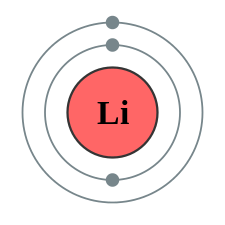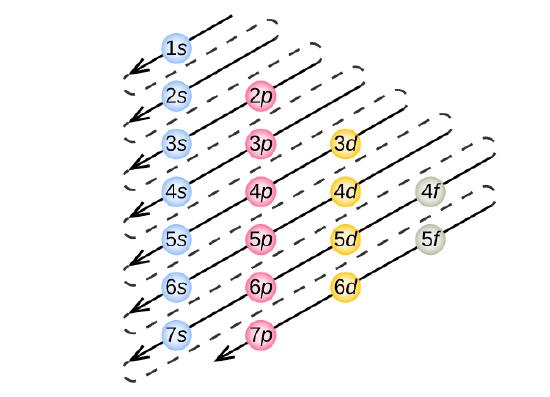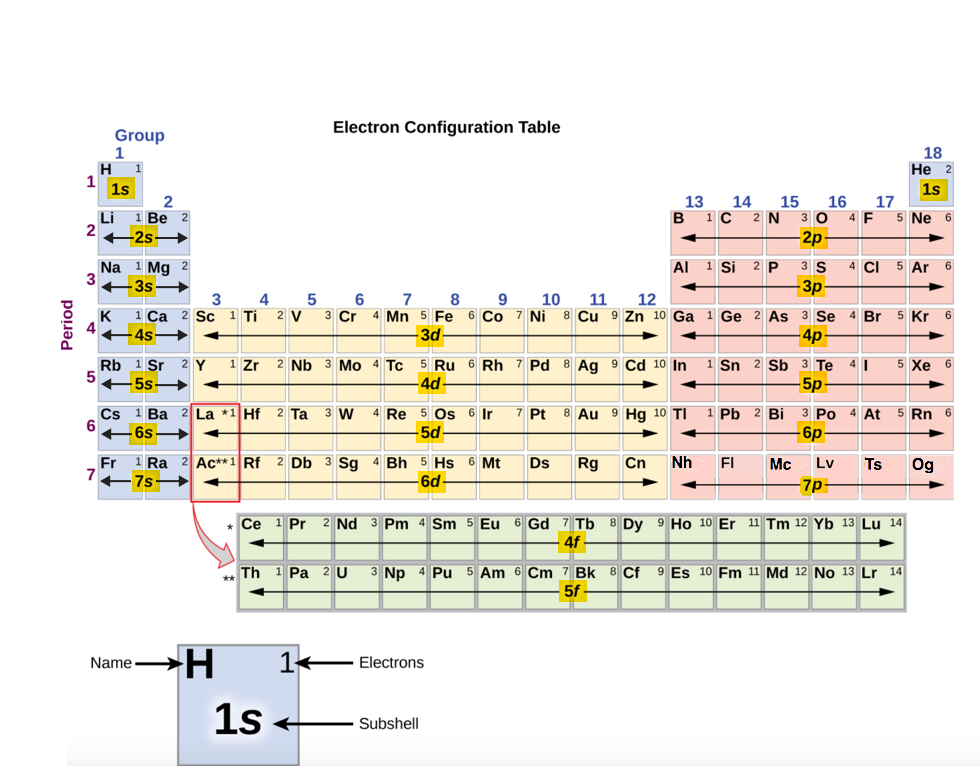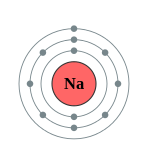Write the Electron Configuration for a Neutral Atom of Phosphorus
2.6: Arrangements of Electrons
-
- Last updated
- Save as PDF
- Page ID
- 16177
Learning Objectives
- Describe how electrons are grouped within atoms.
Although we have discussed the general arrangement of subatomic particles in atoms, we have said little about how electrons occupy the space about the nucleus. Do they move around the nucleus at random, or do they exist in some ordered arrangement?
The modern theory of electron behavior is called quantum mechanics. It makes the following statements about electrons in atoms:
- Electrons in atoms can have only certain specific energies. We say that the energies of the electrons are quantized.
- Electrons are organized according to their energies into sets called shells (labeled by the principle quantum number, n ). Generally the higher the energy of a shell, the farther it is (on average) from the nucleus. Shells do not have specific, fixed distances from the nucleus, but an electron in a higher-energy shell will spend more time farther from the nucleus than does an electron in a lower-energy shell.
- Shells are further divided into subsets of electrons called subshells. The first shell has only one subshell, the second shell has two subshells, the third shell has three subshells, and so on. The subshells of each shell are labeled, in order, with the letters s , p , d , and f . Thus, the first shell has only a single s subshell (called 1 s ), the second shell has 2 s and 2 p subshells, the third shell has 3 s , 3 p , and 3 d and so forth.
| Shell | Number of Subshells | Names of Subshells |
|---|---|---|
| 1 | 1 | 1s |
| 2 | 2 | 2s and 2p |
| 3 | 3 | 3s, 3p and 3d |
| 4 | 4 | 4s, 4p, 4d and 4f |
- Different subshells hold a different maximum number of electrons. Any s subshell can hold up to 2 electrons; p , 6; d , 10; and f , 14.
| Subshell | Maximum Number of Electrons |
|---|---|
| s | 2 |
| p | 6 |
| d | 10 |
| f | 14 |
It is the arrangement of electrons into shells and subshells that most concerns us here, so we will focus on that.
We use numbers to indicate which shell an electron is in. As shown in Table \(\PageIndex{1}\), the first shell, closest to the nucleus and with the lowest-energy electrons, is shell 1. This first shell has only one subshell, which is labeled 1 s and can hold a maximum of 2 electrons. We combine the shell and subshell labels when referring to the organization of electrons about a nucleus and use a superscript to indicate how many electrons are in a subshell. Thus, because a hydrogen atom has its single electron in the s subshell of the first shell, we use 1 s 1 to describe the electronic structure of hydrogen. This structure is called an electron configuration. Electron configurations are shorthand descriptions of the arrangements of electrons in atoms. The electron configuration of a hydrogen atom is spoken out loud as "one-ess-one."
Helium atoms have 2 electrons. Both electrons fit into the 1 s subshell because s subshells can hold up to 2 electrons; therefore, the electron configuration for helium atoms is 1 s 2 (spoken as "one-ess-two").
The 1 s subshell cannot hold 3 electrons (because an s subshell can hold a maximum of 2 electrons), so the electron configuration for a lithium atom cannot be 1 s 3. Two of the lithium electrons can fit into the 1 s subshell, but the third electron must go into the second shell. The second shell has two subshells, s and p , which fill with electrons in that order. The 2 s subshell holds a maximum of 2 electrons, and the 2 p subshell holds a maximum of 6 electrons. Because lithium's final electron goes into the 2 s subshell, we write the electron configuration of a lithium atom as 1 s 22 s 1. The shell diagram for a lithium atom is shown below. The shell closest to the nucleus (first shell) has 2 dots representing the 2 electrons in 1 s , while the outermost shell (2 s ) has 1 electron.

The next largest atom, beryllium, has 4 electrons, so its electron configuration is 1 s 22 s 2. Now that the 2 s subshell is filled, electrons in larger atoms start filling the 2 p subshell. Thus, the electron configurations for the next six atoms are as follows:
- B: 1 s 22 s 22 p 1
- C: 1 s 22 s 22 p 2
- N: 1 s 22 s 22 p 3
- O: 1 s 22 s 22 p 4
- F: 1 s 22 s 22 p 5
- Ne: 1 s 22 s 22 p 6
With neon, the 2 p subshell is completely filled. Because the second shell has only two subshells, atoms with more electrons now must begin the third shell. The third shell has three subshells, labeled s , p , and d . The d subshell can hold a maximum of 10 electrons. The first two subshells of the third shell are filled in order—for example, the electron configuration of aluminum, with 13 electrons, is 1 s 22 s 22 p 63 s 23 p 1. However, a curious thing happens after the 3 p subshell is filled: the 4 s subshell begins to fill before the 3 d subshell does. In fact, the exact ordering of subshells becomes more complicated at this point (after argon, with its 18 electrons), so we will not consider the electron configurations of larger atoms. A fourth subshell, the f subshell, is needed to complete the electron configurations for all elements. An f subshell can hold up to 14 electrons.
Electron filling always starts with 1 s , the subshell closest to the nucleus. Next is 2 s , 2 p , 3 s , 3 p , 4 s , 3 d , 4 p , 5s, 4d, 5p, 6s, etc., shown in the electron shell filling order diagram in Figure \(\PageIndex{2}\). Follow each arrow in order from top to bottom. The subshells you reach along each arrow give the ordering of filling of subshells in larger atoms.

Example \(\PageIndex{1}\): Electronic Configuration of Phosphorus Atoms
Using Figure \(\PageIndex{2}\) as your guide, write the electron configuration of a neutral phosphorus atom. The atomic number of P is 15.
Solution
A neutral phosphorus atom has 15 electrons. Two electrons can go into the 1s subshell, 2 can go into the 2s subshell, and 6 can go into the 2p subshell. That leaves 5 electrons. Of those 5 electrons, 2 can go into the 3s subshell, and the remaining 3 electrons can go into the 3p subshell. Thus, the electron configuration of neutral phosphorus atoms is 1s 22s 22p 63s 23p 3.
Exercise \(\PageIndex{1}\): Electronic Configuration of Chlorine Atoms
Using Figure \(\PageIndex{2}\) as your guide, write the electron configuration of a neutral chlorine atom. The atomic number of Cl is 17.
- Answer
-
A neutral chlorine atom has 17 electrons. Two electrons can go into the 1s subshell, 2 can go into the 2s subshell, and 6 can go into the 2p subshell. That leaves 7 electrons. Of those 7 electrons, 2 can go into the 3s subshell, and the remaining 5 electrons can go into the 3p subshell. Thus, the electron configuration of neutral chlorine atoms is 1s 22s 22p 63s 23p5 .
Since the arrangement of the periodic table is based on the electron configurations, Figure \(\PageIndex{3}\) provides an alternative method for determining the electron configuration. The filling order simply begins at the top left, with hydrogen (Z=1) and includes each subshell as you proceed in increasing atomic number (Z) order.

For example, the first row (Period 1) contains H and He only, because only two electrons are required to fill the 1s subshell. The second row s-block, contains only two elements, Li and Be, to fill the 2s subshell. This is followed by the second row p-block, containing 6 elements (B through Ne) since six electrons are required to fill the 2p subshell. The third row is similar to the second row elements. Two electrons are needed (Na and Mg) to fill the 3s subshell and six electrons are required (Al through Ar) to complete the 3p subshell. After filling the 3p block up to Ar, we see the next subshell will be 4s (K, Ca), followed by the 3d subshell, which are filled by ten electrons (Sc through Zn). The 4p subshell is filled next by six electrons (Ga through Kr). As you can see, the periodic table shown in Figure \(\PageIndex{3}\) provides a simple way to remember the order of filling the subshells in determining the electron configuration. The order of filling subshells is the same: 1s, 2 s , 2 p , 3 s , 3 p , 4 s , 3 d , 4 p , 5s, 4d, 5p, 6s, etc.
Example \(\PageIndex{2}\): Aluminum
Using Figure \(\PageIndex{3}\) as your guide, write the electron configuration of neutral aluminum atom. The atomic number of Al is 13.
Solution
Aluminum has 13 electrons.
Start at Period 1 of the periodic table, Figure \(\PageIndex{3}\). Place two electrons in the 1s subshell (1s2 ).
Proceed to Period 2 (left to right direction). Place the next two electrons in the 2s subshell (2s2 ) and the next six electrons in the 2p subshell (2p6 ).
Proceed to Period 3 (left to right direction) . Place the next two electrons in the 3s subshell (3s2 ) and the last one electron in the 3p subshell (3p1 ).
The electron configuration of Aluminum is 1s22s22p63s23p1
Exercise \(\PageIndex{2}\)
Using Figure \(\PageIndex{3}\) as your guide, write the electron configuration of the atom that has 20 electrons
- Answer
-
Start at Period 1 of Figure \(\PageIndex{3}\). Place two electrons in the 1s subshell (1s2 ).
Proceed to Period 2 (left to right direction). Place the next two electrons in the 2s subshell (2s2 ) and the next six electrons in the 2p subshell (2p6 ).
Proceed to Period 3 (left to right direction) . Place the next two electrons in the 3s subshell (3s2 ) and the next six electron in the 3p subshell (3p6 ).
Proceed to Period 4. Place the remaining two electrons in the 4s subshell (4s2).
The electron configuration is 1s22s22p63s23p64s2
Valence Electrons
In the study of chemical reactivity, we will find that the electrons in the outermost principal energy level are very important and so they are given a special name. Valence electrons are the electrons in the highest occupied principal energy level of an atom.
In the second period elements, the two electrons in the \(1s\) sublevel are called inner-shell electrons and are not involved directly in the element's reactivity or in the formation of compounds. Lithium has a single electron in the second principal energy level and so we say that lithium has one valence electron. Beryllium has two valence electrons. How many valence electrons does boron have? You must recognize that the second principal energy level consists of both the \(2s\) and the \(2p\) sublevels and so the answer is three. In fact, the number of valence electrons goes up by one for each step across a period until the last element is reached. Neon, with its configuration ending in \(2s^2 2p^6\), has eight valence electrons.
The alkali metal sodium (atomic number 11) has one more electron than the neon atom. This electron must go into the lowest-energy subshell available, the 3 s orbital, giving a 1 s 22 s 22 p 63 s 1 configuration. The electrons occupying the outermost shell orbital(s) (highest value of n ) are called valence electrons, and those occupying the inner shell orbitals are called core electrons ( Figure \PageIndex4). Since the core electron shells correspond to noble gas electron configurations, we can abbreviate electron configurations by writing the noble gas that matches the core electron configuration, along with the valence electrons in a condensed format. For our sodium example, the symbol [Ne] represents core electrons, (1 s 22 s 22 p 6) and our abbreviated or condensed configuration is [Ne]3 s 1.

Similarly, the abbreviated configuration of lithium can be represented as [He]2s 1, where [He] represents the configuration of the helium atom, which is identical to that of the filled inner shell of lithium. Writing the configurations in this way emphasizes the similarity of the configurations of lithium and sodium. Both atoms, which are in the alkali metal family, have only one electron in a valence s subshell outside a filled set of inner shells.
\[\ce{Li:[He]}\,2s^1\\ \ce{Na:[Ne]}\,3s^1\]
A chemical reaction results from electron removal, electron addition, or electron sharing of the valence electrons of the different atoms. The path a specific element will take depends on where the electrons are in the atom and how many there are. Thus, it is convenient to separate electrons into two groups. Valence shell electrons (or, more simply, the valence electrons) are the electrons in the highest-numbered shell, or valence shell, while core electrons are the electrons in lower-numbered shells. We can see from the electron configuration of a carbon atom—1s 22s 22p 2—that it has 4 valence electrons (2s 22p 2) and 2 core electrons (1s 2). You will see in the next chapters that the chemical properties of elements are determined by the number of valence electrons.
Example \(\PageIndex{3}\)
Examine the electron configuration of neutral phosphorus atoms in Example \(\PageIndex{1}\), 1s 22s 22p 63s 23p 3 and write the abbreviated notation.
Solution
Phosphorus has electron configuration, 1s 22s 22p 63s 23p 3.
The highest-numbered shell is the third shell (3s 23p 3): 2 electrons in the 3s subshell and 3 electrons in the 3p subshell. That gives a total of 5 valence electrons.
The 10 inner shell (core) electrons, 1s 22s 22p 6 can be replaced by [Ne] (see Figure \(\PageIndex{3}\)). Abbreviated notation is : [Ne]3s 23p 3
Exercise \(\PageIndex{3}\)
Examine the electron configuration of neutral calcium atom (Exercise \(\PageIndex{2}\)), 1s 22s 22p 63s 23p6 4s2 , and write the abbreviated notation.
- Answer
-
The highest-numbered shell is the fourth shell 4s2, which has 2 electrons in the 4s subshell. Hence, Calcium has 2 valence electrons.
The 18 inner-shell (core) electrons, 1s 22s 22p 63s 23p6 , can be replaced by [Ar], see Figure \(\PageIndex{3}\). The abbreviated notation is: [Ar]4s2
Example \(\PageIndex{4}\)
Based on their respective locations in the periodic table (use Figure \(\PageIndex{3}\)), determine the number of valence electrons and the valence shell configuration of elements A, B and C.

Solution
Element A is located in Period 2, the 5th position in 2p-block. Before the electrons are placed in 2p subshell, the 2s subshell must be filled first. This means that A has two valence electrons in 2s (2s2 ) and five valence electrons in 2p (2p5 ). Answer: 2s22p5. It has 2 + 5 = 7 valence electrons.
Element B is located in Period 3, the 2nd position in 3s-block. This means that B has two valence electrons in 3s (3s2 ). Answer: 3s2 .
Element C is located in Period 5, the 1st position in 5s-block). This means that there is only one valence electron in 5s (5s1 ). Answer: 5s1 .
Exercise \(\PageIndex{4}\)
Using the location of Na is the periodic table (Figure \(\PageIndex{3}\)), draw the shell diagram of sodium atom.
- Answer
-
Sodium (Na) is the first element in the 3rd row (Period 3) in the periodic table. This means that the first shell and second shells of Na atom are filled to the maximum number of electrons.
The first shell (1s) is filled with 2 electrons. The second shell (2s and 2p) has a total of 8 electrons . And, the third (last) shell has 1 electron .
The shell diagram of the Na atom is shown below. The shell nearest the nucleus (first shell) has 2 electrons (2 dots), the second shell has 8 electrons and the last (outermost) shell has 1 electron. (2.8.1)

Concept Review Exercises
- How are electrons organized in atoms?
- What information does an electron configuration convey?
- What is the difference between core electrons and valence electrons?
Answers
- Electrons are organized into shells and subshells around nuclei.
- The electron configuration states the arrangement of electrons in shells and subshells.
- Valence electrons are in the highest-numbered shell; all other electrons are core electrons.
Key Takeaway
- Electrons are organized into shells and subshells about the nucleus of an atom.
- The valence electrons determine the reactivity of an atom.
Exercises
Write the Electron Configuration for a Neutral Atom of Phosphorus
Source: https://chem.libretexts.org/Bookshelves/Introductory_Chemistry/Book%3A_The_Basics_of_GOB_Chemistry_(Ball_et_al.)/02%3A_Elements_Atoms_and_the_Periodic_Table/2.06%3A_Arrangements_of_Electrons#:~:text=Thus%2C%20the%20electron%20configuration%20of,63s23p3.
0 Response to "Write the Electron Configuration for a Neutral Atom of Phosphorus"
Enregistrer un commentaire